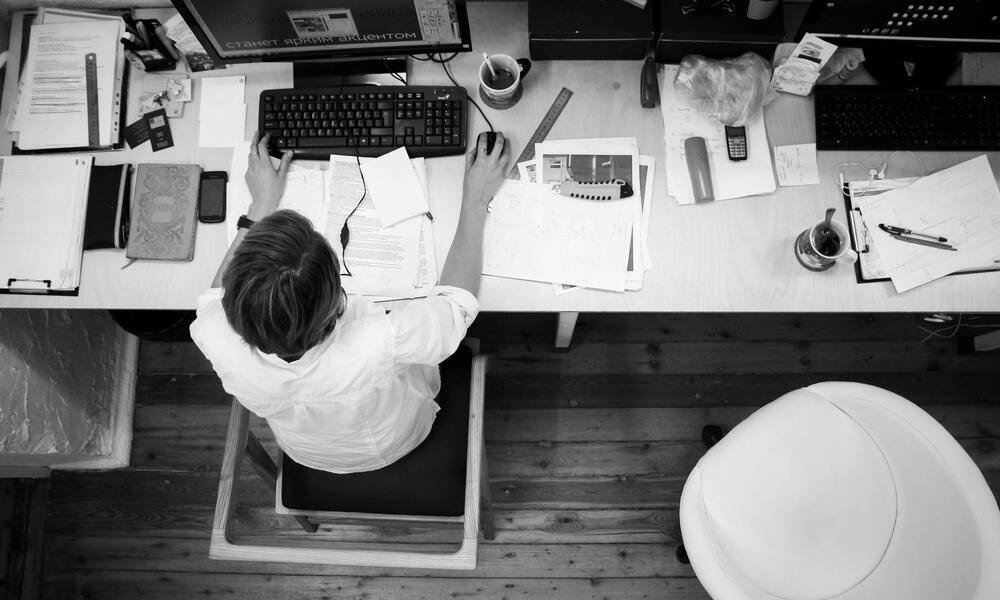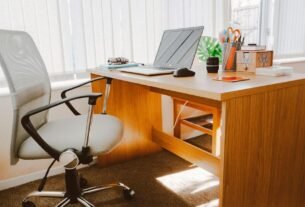A cluttered office table can negatively impact your productivity and mental well-being. With piles of papers, scattered office supplies, and random knick-knacks taking up valuable workspace, it’s easy to feel overwhelmed. Decluttering your office table not only creates a more organized and efficient work environment but also enhances your ability to focus and reduces stress. In this comprehensive guide, we’ll walk you through a step-by-step process to declutter your office table, along with tips to maintain a tidy workspace.
Why Declutter Your Office Table?
Before diving into the how-to, it’s important to understand why decluttering your office table is essential. Here are some key benefits:
- Increased Productivity: A clean and organized workspace helps you find what you need quickly, reducing time spent searching for items and allowing you to focus more on your tasks.
- Reduced Stress: Clutter can be a significant source of stress. An organized workspace can promote a sense of calm and control, leading to improved mental well-being.
- Enhanced Creativity: A clutter-free environment can stimulate creativity by providing a clear, distraction-free space to brainstorm and develop new ideas.
- Professionalism: A tidy office table projects a professional image, whether you’re working from home or in a corporate setting. It shows that you are organized and take your work seriously.
- Improved Health: Clutter can accumulate dust and allergens, affecting your physical health. A clean workspace contributes to a healthier environment.
Step-by-Step Guide to Decluttering Your Office Table
Step 1: Clear Everything Off
The first step in decluttering your office table is to clear everything off the surface. This might seem daunting, but it’s necessary to get a fresh start.
- Create a Temporary Space: Use a nearby table, the floor, or a large box to temporarily hold all the items from your desk.
- Categorize Items: As you remove items, categorize them into groups such as papers, office supplies, electronics, personal items, and trash. This will make it easier to sort through them later.
Step 2: Clean the Surface
With your desk cleared, take the opportunity to give it a thorough cleaning.
- Dust and Wipe Down: Use a microfiber cloth to dust the surface and any shelves or drawers. Wipe down the desk with a suitable cleaner to remove any grime or stains.
- Sanitize: If you use your desk frequently, it’s a good idea to sanitize it to eliminate germs and bacteria.
Step 3: Sort and Purge
Now that your desk is clean, it’s time to sort through the items you removed and decide what to keep, what to discard, and what to relocate.
- Papers: Go through all the papers and sort them into categories such as urgent, important, to be filed, and to be shredded. Be ruthless and only keep what you need.
- Office Supplies: Assess the supplies you have. Discard broken or unnecessary items. Keep only the essentials that you use regularly.
- Electronics: Evaluate your electronic devices and accessories. Keep only what is necessary for your daily work. Store rarely used items elsewhere.
- Personal Items: Limit personal items on your desk to a few meaningful or motivational pieces. Too many personal items can contribute to clutter.
- Trash: Discard any trash or items that are no longer useful. Recycle when possible to minimize waste.
Step 4: Organize Essentials
With a reduced number of items, it’s time to organize what remains on your desk.
- Create Zones: Divide your desk into zones based on function. For example, have a zone for your computer and related accessories, a zone for paperwork, and a zone for office supplies.
- Use Organizers: Invest in desk organizers such as trays, bins, and drawer dividers to keep items neatly sorted. Use a filing system for papers and folders.
- Keep It Simple: Aim to keep your desk surface as clear as possible. Store items you use frequently within easy reach, and place less-used items in drawers or cabinets.
Step 5: Cable Management
Cables can easily become tangled and contribute to a messy desk. Implement cable management solutions to keep them under control.
- Cable Ties: Use cable ties or Velcro straps to bundle and secure cables together.
- Cable Clips: Attach cable clips to the edge of your desk to keep charging cables and other cords organized and accessible.
- Cable Trays: Install a cable tray under your desk to keep larger power strips and cables off the floor and out of sight.
Step 6: Maintain Your Decluttered Desk
Decluttering is not a one-time task; it requires ongoing effort to maintain. Here are some tips to help you keep your desk clutter-free:
- Daily Tidying: Spend a few minutes at the end of each day tidying up your desk. Put away items, file papers, and ensure everything is in its designated place.
- Weekly Check-ins: Set aside time each week to review and organize your desk. This will prevent clutter from building up over time.
- Adopt a Minimalist Mindset: Be mindful of what you bring onto your desk. Only keep items that serve a purpose or bring you joy. Avoid accumulating unnecessary items.
Tips for a Functional and Organized Desk
In addition to the decluttering steps, consider these tips to enhance the functionality and organization of your desk:
1. Use Vertical Space
Maximize your desk space by utilizing vertical storage solutions.
- Shelves: Install shelves above or near your desk to store books, binders, and other items.
- Wall Organizers: Use wall-mounted organizers, such as pegboards or magnetic boards, to keep frequently used items within reach.
2. Optimize Drawer Space
Drawers can quickly become cluttered if not organized properly.
- Drawer Dividers: Use dividers to separate different types of items, making it easier to find what you need.
- Labeling: Label drawers to clearly indicate their contents, helping you maintain organization.
3. Digital Organization
A cluttered digital workspace can be just as distracting as a physical one.
- File Management: Organize your digital files into folders and subfolders. Use clear, descriptive names to make them easy to find.
- Desktop Cleanup: Keep your computer desktop free of unnecessary icons and files. Use a digital filing system to store documents.
4. Ergonomic Setup
An ergonomic setup can enhance your comfort and productivity.
- Chair and Desk Height: Ensure your chair and desk are at the proper height to promote good posture. Your feet should be flat on the floor, and your elbows should be at a 90-degree angle.
- Monitor Position: Position your monitor at eye level to reduce strain on your neck and eyes. Use a monitor stand if needed.
- Keyboard and Mouse Placement: Keep your keyboard and mouse within easy reach to avoid straining your wrists and arms.
5. Personal Touches
While it’s important to keep personal items to a minimum, a few meaningful touches can make your workspace more inviting.
- Plants: Add a small plant to your desk to bring a touch of nature indoors. Plants can improve air quality and boost your mood.
- Inspirational Quotes: Display a few motivational quotes or photos that inspire you. Keep them in a designated area to avoid clutter.
Common Challenges and Solutions
1. Limited Space
If you have a small desk or limited workspace, it can be challenging to keep everything organized.
- Solution: Prioritize the most essential items and find creative storage solutions. Use wall-mounted organizers and maximize vertical space to keep your desk clear.
2. Paper Piles
Paperwork can quickly accumulate and create clutter.
- Solution: Implement a filing system and set aside time each week to sort and file papers. Consider going digital by scanning important documents and storing them electronically.
3. Procrastination
Decluttering can be time-consuming, and it’s easy to procrastinate.
- Solution: Break the task into smaller, manageable steps. Set a timer for 15-30 minutes each day to work on decluttering. Celebrate your progress to stay motivated.
4. Sentimental Items
Personal and sentimental items can be difficult to part with.
- Solution: Limit sentimental items to a few cherished pieces. Consider creating a dedicated space, such as a memory box, for items that hold special meaning but don’t need to be on your desk.
Conclusion
Decluttering your office table is a transformative process that can enhance your productivity, reduce stress, and create a more pleasant work environment. By following the step-by-step guide and implementing the tips provided, you can achieve and maintain a clutter-free, organized workspace. Remember, the key to successful decluttering is consistency and mindfulness. Regularly review your desk, prioritize functionality, and embrace a minimalist mindset to enjoy the full benefits of an organized office table.
FAQs for How to Declutter Your Office Table
1. Why is it important to declutter my office table?
Decluttering your office table is important because it can increase productivity, reduce stress, enhance creativity, project professionalism, and improve overall health by reducing dust and allergens. A tidy workspace promotes a more organized and efficient work environment, allowing you to focus better on your tasks.
2. What should I do with all the papers on my desk?
Sort the papers into categories such as urgent, important, to be filed, and to be shredded. Keep only the necessary documents and use a filing system for organization. Consider digitizing important documents to reduce physical clutter and make them easier to access.
3. How can I manage cables and cords on my desk?
Use cable ties or Velcro straps to bundle and secure cables. Attach cable clips to the edge of your desk to keep charging cables and other cords organized and accessible. Install a cable tray under your desk to keep larger power strips and cables off the floor and out of sight.
4. What are some tips for maintaining a clutter-free desk?
- Spend a few minutes at the end of each day tidying up your desk.
- Set aside time each week to review and organize your desk.
- Adopt a minimalist mindset by keeping only items that serve a purpose or bring you joy.
- Regularly declutter and avoid accumulating unnecessary items.
5. How can I maximize storage space on a small desk?
Maximize storage space by utilizing vertical storage solutions like shelves and wall organizers. Use drawer dividers and labels to keep items organized. Prioritize essential items and find creative storage solutions to keep your desk surface clear and functional.
6. How do I decide which personal items to keep on my desk?
Limit personal items to a few meaningful or motivational pieces that bring you joy or inspiration. Too many personal items can contribute to clutter, so choose selectively and keep them in designated areas to maintain a tidy and organized workspace.




